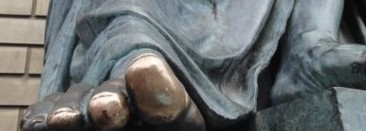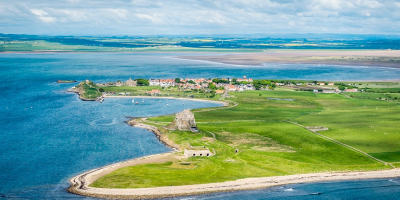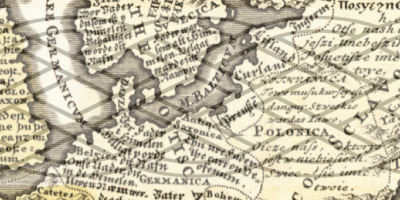‘What has Christianity ever done for me?’ a comedian once asked on Scottish television. This question was repeated by our guide in Edinburgh this week on our Celtic Heritage Tour through Ireland, Scotland and England, as he led us down the Royal Mile from the castle towards St Giles Cathedral.
Dressed as the Celtic missionary St Cuthbert, Paul James-Griffiths plied our group of 15 travellers with stories and anecdotes, facts and figures, about the role Christians and Christianity played in shaping law, democracy, science, medicine, human rights, education, healthcare and social reform in Scotland, Britain and beyond.
He began with the coming of the Christians to what we now call Scotland, Ninian being one of the first to build a stone church north of Hadrian’s Wall in 397AD. Kentigern (Mungo) founded a church in what he called Glas-gu (beloved church). Glasgow’s motto still today is: Lord, let Glasgow flourish through the preaching of Thy Word and the praise of Thy Name. Later other Celtic missionaries came, like Columba, founder of Iona, Aidan, founder of Lindisfarne, and Cuthbert, who used to preach from near the castle.
Centuries later, John Knox became the central figure of the Scottish Reformation, bringing insights from Calvin’s Geneva back to Edinburgh. Presbyterian church government–where church leaders were voted in by the members–became a model for a democratic Parliament. Paul quoted an historian saying about Knox, that ‘the ideal he gave Scotland as a legacy was of a democratic state, caring for its weakest members, with free education available to all.’ One of the greatest architects of democracy in Scotland was the Reverend Samuel Rutherford (1600-1661), whose book Lex Rex (The law is king) challenged the prevailing divine right of kings (Rex Lex – the king is law).
Freedom
On the Continent, the Reformation paved the way for enquiry, investigation and freedom of conscience and speech, Paul explained. Christians believed that God had made an orderly universe and that nature should be carefully examined to learn from it and invent things for the benefit of others. From this understanding emerged great pioneer scientists who were devout believers, including Kepler, Newton, Pascal, Boyle and Euler.
This tradition continued in Edinburgh, which produced believing scientists like John Napier (1550-1617), inventor of the logarithm; Thomas Young (1773-1829), who showed how light acted as a wave; Sir David Brewster (1781-1868) inventor of the kaleidoscope and who laid the foundation for laser technology; and James Clerk Maxwell (1831-1879), voted in 2010 as Scotland’s greatest scientist, and founder of Cambridge’s world-famous Cavendish Laboratory, and Einstein’s hero. Without Maxwell, pioneer of our technological revolution, Paul doubted that we would have had televisions, computers, mobile phones and X-ray machines, for example. Other believers included Sir James Young Simpson, pioneer of anaesthetics; Lord Joseph Lister, father of antiseptics; David Octavius Hill, Robert Adamson and Sir David Brewster who pioneered modern photography.
Free education was pioneered by Christians in Scotland, as in many other European countries. The four oldest Scottish universities were founded by the church (St Andrews, Aberdeen, Glasgow and Edinburgh). A protest movement of Christian Covenanters starting in Edinburgh demanding freedom of religion, in which 18,000 were killed by the state, led eventually to the English Bill of Rights and the Scottish Claim of Right Act of 1689, and inspired the United States Bill of Rights (1789).
Superstition
There was however another side to Edinburgh, which became a centre for that revival of Greek philosophy called the Enlightenment. Edinburgh became known as ‘Athens of the North’. Two statues close to each other on the Royal Mile depict two sons of the city whose influence has been truly global. Adam Smith (1723-1815), capitalism’s founding father, was best friend to David Hume (1711-1776), himself known as the father-figure of the Enlightenment.
As we stood around the bronze image of Hume dressed in a Greek tunic, Paul pointed to the large tablet the philosopher held in one hand, his foot resting on the other. The sculptor had deliberately left the tablets blank, suggesting that the Ten Commandments were null and void. Hume himself had written in his Treatise that ‘all distinction betwixt virtue and vice is merely imaginary’; and, ‘Justice has no foundation further than it contributes to public advantage.’
Often considered an atheist by contemporaries, Hume was not always consistent in what he wrote about religion, but was clearly unorthodox enough for the Church of Scotland to consider heresy charges. The revival of ancient Greek philosophy led him to develop naturalistic explanations of the universe, without any need of a God, paving the way towards the modern era of unbelief.
As we stood listening to Paul, several passers-by approached the statue, rubbed their hands over Hume’s bronze toe, and disappeared back into the crowd. A tradition had developed among students, explained Paul, that to touch Hume’s toe brought good luck during exams. Well, something had to fill the spiritual vacuum.
Till next week,



